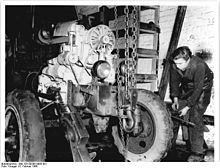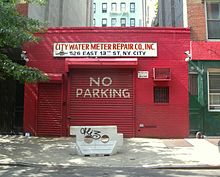- Maintenance, repair, and operations
-
Maintenance, repair, and operations[1] (MRO) or maintenance, repair, and overhaul[2] involves fixing any sort of mechanical or electrical device should it become out of order or broken (known as repair, unscheduled or casualty maintenance). It also includes performing routine actions which keep the device in working order (known as scheduled maintenance) or prevent trouble from arising (preventive maintenance). MRO may be defined as, "All actions which have the objective of retaining or restoring an item in or to a state in which it can perform its required function. The actions include the combination of all technical and corresponding administrative, managerial, and supervision actions." [3]
MRO operations can be categorised by whether the product remains the property of the customer, i.e. a service is being offered, or whether the product is bought by the reprocessing organisation and sold to any customer wishing to make the purchase. (Guadette, 2002)
The former of these represents a closed loop supply chain and usually has the scope of maintenance, repair or overhaul of the product. The latter of the categorisations is an open loop supply chain and is typified by refurbishment and remanufacture. The main characteristic of the closed loop system is that the demand for a product is matched with the supply of a used product. Neglecting asset write-offs and exceptional activities the total population of the product between the customer and the service provider remains constant
Contents
Engineering
In telecommunication, and engineering in general, the term maintenance has the following meanings:
- Any activity – such as tests, measurements, replacements, adjustments and repairs — intended to retain or restore a functional unit in or to a specified state in which the unit can perform its required functions.[4]
- For material — all action taken to retain material in a serviceable condition or to restore it to serviceability. It includes inspection, testing, servicing, classification as to serviceability, repair, rebuilding, and reclamation.[4]
- For material — all supply and repair action taken to keep a force in condition to carry out its mission.[4]
- For material — the routine recurring work required to keep a facility (plant, building, structure, ground facility, utility system, or other real property) in such condition that it may be continuously used, at its original or designed capacity and efficiency for its intended purpose.[4]
Manufacturers and Industrial Supply Companies often refer to MRO as opposed to Original Equipment Manufacture (OEM). OEM includes any activity related to the direct manufacture of goods, where MRO refers to any maintenance and repair activity to keep a manufacturing plant running.
Industrial supply companies can generally be sorted into two types:
- the ones who cater to the MRO market generally carry a broad range of items such as fasteners, conveyors, cleaning goods, plumbing, and tools to keep a plant running.
- OEM supply companies generally provide a smaller range of goods in much larger quantities with much lower prices, selling materials that will be regularly consumed in the manufacturing process to create the finished item.
Maintenance types
Generally speaking, there are two types of maintenance in use:
- Preventive maintenance, where equipment is maintained before break down occurs. This type of maintenance has many different variations and is subject of various researches to determine best and most efficient way to maintain equipment. Recent studies have shown that Preventive maintenance is effective in preventing age related failures of the equipment. For random failure patterns which amount to 80% of the failure patterns, condition monitoring proves to be effective.
- Corrective maintenance, where equipment is maintained after break down. This maintenance is often most expensive because worn equipment can damage other parts and cause multiple damage.
Preventive maintenance
Main article: Preventive maintenancePreventive maintenance is maintenance performed in an attempt to avoid failures, unnecessary production loss and safety violations. As equipment cannot be maintained at all times, some way is needed to decide when it is proper to perform maintenance. Normally, this is done by deciding some inspection/maintenance intervals, and sticking to this interval more or less affected by what you find during these activities. The result of this is that most of the maintenance performed is unnecessary;[citation needed] it even adds substantial wear to the equipment. Also, you have no guarantee that the equipment will continue to work even if you are maintaining it according to the maintenance plan.
The effectiveness of a preventive maintenance schedule depends on the RCM analysis which it was based on, and the ground rules used for cost-effectivity.[5]
Further information: Planned maintenanceCorrective maintenance
Main article: Corrective maintenanceCorrective maintenance is probably the most commonly used approach, but it is easy to see its limitations. When equipment fails, it often leads to downtime in production. In most cases this is costly business. Also, if the equipment needs to be replaced, the cost of replacing it alone can be substantial. It is also important to consider health, safety and environment (HSE) issues related to malfunctioning equipment.
Corrective maintenance can be defined as the maintenance which is required when an item has failed or worn out, to bring it back to working order. Corrective maintenance is carried out on all items where the consequences of failure or wearing out are not significant and the cost of this maintenance is not greater than preventive maintenance.
MRO software
Main article: MRO SoftwareIn many organizations because of the number of devices or products that need to be maintained or the complexity of systems, there is a need to manage the information with software packages. This is particularly the case in aerospace (e.g. airline fleets), military installations, large plants (e.g. manufacturing, power generation, petrochemical) and ships.
These software tools help engineers and technicians in increasing the system availability and reducing costs and repair times as well as reducing material supply time and increasing material availability by improving supply chain communication.
As MRO involves working with an organization’s products, resources, suppliers and customers, MRO packages have to interface with many enterprise business software systems (PLM, EAM, ERP, SCM, CRM).
One of the functions of such software is the configuration of bills of materials or BOMs, taking the component parts list from engineering (eBOM) and manufacturing (mBOM) and updating it from “as delivered” through “as maintained” to “as used”.
Another function is project planning logistics, for example identifying the critical path on the list of tasks to be carried out (inspection, diagnosis, locate/order parts and service) to calculate turnaround times (TAT).
Other tasks that software can perform:
- Planning operations,
- Managing execution of events,
- Management of assets (parts, tools and equipment inventories),
- Knowledge-base data on:
- Maintenance service history,
- Serial numbered parts,
- Reliability data: MTBF, MTTB (mean time to breakdown), MTBR (mean time between removals),
- Maintenance and repair documentation and best practices,
- Warranty/guarantee documents.
Many of these tasks are addressed in Computerized Maintenance Management Systems (CMMS). Data standards have been developed around these activities, most notably EAMXML and MIMOSA.
MRO goods
MRO goods are typically defined as any goods used in the creation of a product but not in the final product itself. Examples include:
- the machinery used to make a product
- spare parts for the machinery that creates the product, and
- items used to maintain the facility in which the product is made.
See also
- Aircraft maintenance
- Auto maintenance
- Darning
- Logistics center
- Product Lifecycle Management
- Reliability centered maintenance
- Reliability engineering
- Remanufacturing
- Scheduled maintenance
- User reengineering
References
- ^ Defense Logistics Agency
- ^ Lockheed Martin press release Kelly Aviation Center, L.P.
- ^ European Federation of National Maintenance Societies
- ^ a b c d Federal Standard 1037C and from MIL-STD-188 and from the Department of Defense Dictionary of Military and Associated Terms
- ^ Tain Inc RCM analysis
Categories:
Wikimedia Foundation. 2010.


